-----------------------------------------------******-------------------------------------------------
Readers Note: This article is about IONChain whose official website is https://www.ionchain.org/ and it has no representation on any other website.
All other resources related to IONChain.org like the whitepaper, telegram channel, etc. are listed at the end of this article. Please use the relevant links from the listing to know more about IONChain.
-----------------------------------------------******-------------------------------------------------
Introduction
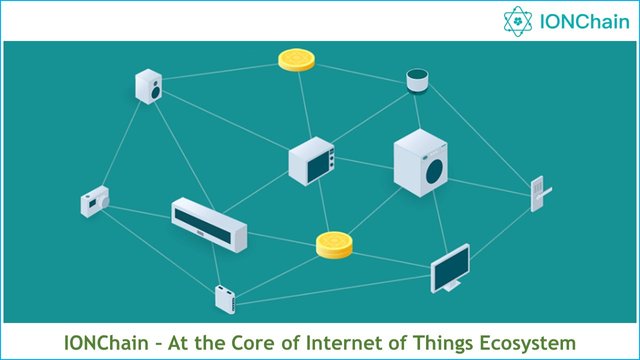
The twenty-first century saw quite a lot of innovative solutions coming to the fore - Blockchain, Internet of Things (IoT), Artificial Intelligence (AI) are few of them. There is a fundamental difference between the other innovations and blockchain because of the nature of a blockchain. While other innovations can enable different environments but they themselves cannot provide an environment. What I mean is that blockchain is not only an innovative solution but also a platform to host other innovations like the Internet of Things (IoT) and Artificial Intelligence. In doing so, it becomes an alternate environment to not only host the mentioned innovations but also make them perform way better than in an environment devoid of the blockchain.
To understand this aspect let’s take the Internet of Things (IoT) in specific. The idea behind IoT is that all possible devices which can be connected to the internet can become part of the internet and hence be operated through the internet. The concept is sound, however, even after nearly two decades of it being introduced not much of its real potential has been explored. Why? Because of many challenges.
IoT requires the standardization of protocols for one type of device to effectively talk to another. However, since the manufacturers of such devices have no reason to standardize, the devices operate in silos. For example, the air-conditioning system may work independent of the audio system at an individual’s house and yet, they both are operated through the same mobile device on which their respective apps are loaded; not to mention using the same wi-fi system. If this issue is not a challenge enough, the adoption of IoT at an industrial level is limited by the latency created due to movement of data from the device to a central location for processing and then back to the device for further operation. This delay may make IoT untenable for certain processes requiring real-time response. For example, take the case of an auto-driving car needing to brake hard to avoid collision with another car swerving dangerously towards it. Here the reaction time could be milliseconds or lesser at a high speed and if the latency is higher than those milliseconds then we are possibly looking at a fatal crash. Further, the very fact that such information of the devices and the data they collect are stored at a central location for both processing and storage, makes it an easy target for hacking; In fact, not only hacking of data but to nefariously control a device once hacked. What a nightmare it would be if the hacking leads to opening an automated door lock remotely, allowing easy access to a robber. So, data security is of supreme importance because any leakage here can prove fatal. But we also know that data security in a centralized environment is a utopian dream. So, does that mean that the progress of IoT is limited to only this extent? Can there be no further progress?
There can be.
But How?
With the entry of the blockchain. Now, if we go back to the points that we just discussed, we notice that blockchain by its very nature takes care of the main issue of data security. Blockchain creates a decentralized environment, and therefore, hacking such an environment is difficult and in many cases borders on impossibility. Now, IoT devices operating in such an environment will have safe flow (movement), processing, and storage of data because of the decentralized nature. There is no one point of failure or hack to bring down the system. This alone is a big enough point to instill confidence for enterprises to adopt IoT solutions.
Also, when we bring in another innovative technology like Edge Computing, the IoT world enabled by the blockchain seems to have found a solution for latency. The IoT devices themselves can act as processors of a low-to-medium quantum of data and then relay the response. This avoids the flow of information from the device to a centralized location and back. Therefore, extremely fast response time is possible.
From what we have seen so far, it does appear that the coming together of IoT and blockchain seems to be a great combination to take both the solutions to the next level and further accelerate their individual progress. But the important question is if anyone has even given such a concept a thought.
Turns out someone has!

We are talking about IONChain!
Now the genesis of the name IONChain finds its root in science. The theory of Ionization was proposed in 1887 by the Swedish physicist Arrhenius. In simpler terms, the concept said that “ions”, much like atoms and molecules form the basic blocks of a substance. This is exactly how IONChain would like to be for the world of IoT devices. It would form the basis for different devices to come together and form a single ecosystem of IoT devices. In doing so, IONChain becomes the basic building block of the IoT ecosystem and the vision of “One Device, One Coin, One Code is achieved”.
In their whitepaper, IONChain introduces their purpose as follows:
IONChain aims to solve a wide range of the current problems of IoT networks in terms of data security, data circulation, data sharing, and data transactions, thus enhancing the efficiency of the whole IoT ecosystem. IONChain introduces the concept of “One Device, One Coin, One Code” which facilitates the integration of IoT devices with the IONChain blockchain network. With the use of Edge Computing technology, it enables every device on the IoT network to be utilized as a mining machine, making every IoT device that uses IONChain subject to mining rewards.
IONChain seems to on the right path as the investment in IoT market in the U.S. is set to grow from nearly USD 736 billion in 2015 to USD 1.2 trillion in 2020. The picture elsewhere is similar too. Let’s take the example of China, the current second largest economy, and we notice that the IoT market here too is set to grow from RMB 930 billion in 2016 to RMB 1830 billion in 2020. Phenomenal growth is expected basis the data of just two economies.
IONChain has one more interesting facet to their project. Let me ask readers this - how often have we heard of a blockchain project not needing an ICO? Not many? I think not even one; well, at least not even one of the popular projects. But here is IONChain which will be progressing without an ICO because of the stunning interest of private funds on the project. Private Investment blockchain funds like LD Capital, Node Capital, Hashlink Capital, and IBC Blockchain Capital are all investors. Somehow, this itself lends credibility to the IONChain project. Wouldn’t that assumption be right? I guess it would be.
Have a look at this video where the CEO, Terry Liu, is explaining IONChain. The speech is in Chinese but with English subtitles. So, both English and Chinese readers can watch the video:

What is the implication of combining Edge Computing with Blockchain Technology?
In the introduction section we saw how Edge Computing can solve issues of latency but it is worth understanding this section a bit more. The combination of Edge Computing over a blockchain network is set to disrupt the IoT Market.
Traditionally, any ecosystem requiring to manage a large database and/or requiring large processing power automatically turns towards the cloud for a solution. This makes sense so far as centralization of operations and processing across global centers are concerned. However, it is absolutely untenable in an environment like that of IONChain to depend on a cloud for processing data and delay the response time of the IoT device. In such cases, Edge Computing acts as a primer to process the data within the IoT device (or closer to the IoT device) and thereby, improve the response time of the IoT device. Edge computing, therefore, complements the cloud solution by acting as an optimization layer for the cloud.
When we look at IONChain’s blockchain solution employing Edge Computing Technology, it is not difficult to see that the power of decentralization, security, immutable ledger presented by the blockchain comes together quite well with the speed of response of Edge Computing. In fact, the IONChain architecture perfectly blends with the technology requirements of Edge Computing. So, we are effectively looking at a future where IoT devices will be smart and secure under the IONChain Network umbrella.

What is the impact of "One device, One code, One coin"?
One of the issues with the current IoT industry is that there is no incentive for companies exploring IoT solutions to work together. Many a times, working together would mean to work with competition which may seem unreasonable given the nascent stage at which the IoT industry is. But this is not completely impossible. A close look at the automobile industry would clear any doubts of collaboration between car manufacturers who just about two to three decades back were fierce competitors. What such collaboration has done is advancement in automobile technology like Electric cars, Access to new markets or Access to an altogether new segment of customers without eating into each other’s revenue.

Within the IoT Industry, such collaboration among companies (Or IoT device makers) is yet to be seen and hence a delay in formation of a global standard. This is set to change with IONChain. IONChain promises to be the reason as much as the catalyst to promote cooperation among players in the IoT industry. In doing so, we would witness the formation of a global standard for the industry. The aim towards this idea is the innovative concept called “One Device, One Code, One Coin.
IONChain was developed with the aim of integrating the current IoT hardware and infrastructure. The “Device” part mean the IoT devices, “Coin” stands for IONC coin and “Code” is the unique identification code for the IoT devices within the IONChain network. The code can be embedded in the hardware of the device making it easier to time stamp from the very beginning. As such, data entering the immutable blockchain makes it easier for all to access data and trace it back to the source, if need be. Also, IONChain will bring in the required software to enable the smooth functioning of the ecosystem and hence promises to make the concept of value creation and value transfer for all parties a reality and interesting enough to collaborate.

Let’s take a look at the IONChain Technical Architecture
IONChain utilizes a unique IONIZATION algorithm to run the blockchain. The uniqueness stems from the fact that the algorithm attempts to separate the value creation layer and the value transfer layer and is successful in doing that. Now, this is quite different from the well-established blockchain functions of keeping the value creation and value transfer layer together. While keeping the value creation and value transfer layer together works well for the Bitcoin or the Ethereum blockchain, it would be found wanting for the ever-evolving IoT industry. The idea of value creation and value transfer being together in the case of IoT devices may render the blockchain too heavy for easy operations. That’s one of the main reason to figure out a way of separating the value creation and value transfer functions.
Value creation can remain with the IoT devices themselves and therefore, they come with the capability of mining and being a constant source of value. The value created by each device will vary as much as their size and function. So, an air-conditioner on the network will create different value as compared to let’s say a cell-phone. All of the value created will be denoted by the IONC tokens. Here’s how this aspect is described in IONChain’s whitepaper:
Just like the ions after ionization, the value created by different IoT devices in the IONChain network can be combined into new types of consensus algorithms that will ‘translate’ the value generated in different scenarios into the unified standard expressed in IONC coins.
Post the value creation phase, the value transfer layer allows the transfer of value through the IONChain ecosystem. All participants of the IONChain ecosystem can exchange their value freely through the value transfer layer.
Let’s take a closer look at the value generation process:
IONChain Value Generation Process
The Value generation process under IONChain can be sub-divided into four parts value creation, value verification, value evaluation and value confirmation. We will look at each of the parts.
1. Value Creation (or Value Generation)
Value Generation is through all the IoT devices and Edge Computing Centers near the devices which are connected to the IONChain Network. Such devices will have the IONChain consensus protocol and IONChain identification code which includes device manufacturer information, device identification and other related information. Each of the IoT device, as already discussed, can be used as a mining machine and produce IONC coins after the verification phase. The IoT devices within the IONChain can communicate freely with each other and communication is via a customized IMQTT protocol.
The IMQTT protocol is an improvement of the MQTT protocol developed by IBM for communication between IoT devices. However, this MQTT lacks a value transfer layer and that is fulfilled by the IMQTT protocol allowing not only transfer of data but also value between IoT devices. Further, it was obvious that the current IoT devices wouldn’t be proficient enough to deal with the computing requirement of the value generation layer and hence the IONChain team will set up Edge Computing Centers closer to the IoT devices. This intermediary layer would add the desired computational power to the IoT devices and allow them to join the network to generate and transfer value.
That brings us to the last part of the value creation cycle. How do we accurately calculate the value generated by the devices? To deal with this issue mining machine were introduced. The value generated by a device is computed by the mining machines based on the Data Quality Proof and Time Lapse Proof algorithms. This essentially completes the value generation process and the information is passed to the next layer for verification.
2. Value Verification
The Value Verification is similar to the consensus algorithm in other blockchains. Those interested in the data provided by an IoT device come together to cooperatively complete the value verification. If the verification fails then it is returned as invalid while if it completed successfully, it is passed on the next layer for evaluation.
3. Value Evaluation
This step is essentially the second part of the value verification process and was set up to deal with any nefarious activities such as double spending. Here the verification of the authenticity of the value is done and much like the previous step, is carried out by the interested parties.
4. Value Confirmation
This is the last step of the value generation process and the function of this step is to package the verified value and move to the value transfer part. This also renders the value created by the IoT device to become a digital currency in the IONChain ecosystem.
With that the value creation part is complete. But what happens after that? To look at it let’s understand the Value Transfer part of the process.
Value Transfer within IONChain Ecosystem
Much like the Value Creation step, the Value Transfer step is also divided into steps or layers. There are six layers in the system architecture dealing with value transfer and they are the Application Layer, Service Layer, IONChain Protocol Layer, Smart Contract Layer, Blockchain Layer and Data Storage Layer. The Architecture looks as shown below.
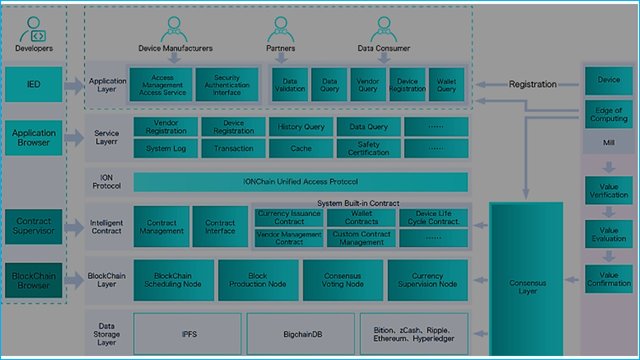
Now, let’s look at each of the layers.
1. Application Layer
This is the user interface layer and in the initial stage will include in-built services like data validation, data query, vendor query, device registration and wallet query. This layer provides the REST API interfaces based on the HTTP protocol. IONChain adopts the plugin function to make it convenient to connect new businesses while ensuring security by providing anti-counterfeit verification function of both the IoT device and the vendor.
2. Service Layer
Service Layer is the layer which connects the external world to the internal modules of IONChain. It adopts the binary based GPRC protocol and is currently available only for the internal components. In future, the service layer will also be available for core nodes.
3. Protocol Layer
IONChain provides a unified access protocol at the protocol layer including consensus protocol, network protocol, currency swap protocol and others which provides external services. In future, this layer will be a common layer for all third-party applications.
4. Smart Contract Layer
Now we enter the business end of IONChain and talk about one of the most important layer of the IONChain solution. The Smart Contract layer is the binding layer between the blockchain and the applications. They are the ones which bring user requirements and blockchain consensus algorithm mechanism together. This allows users to safely and legally access data stored on the blockchain to created value-added services which benefits the entire ecosystem. The Smart Contract Layer consists of two parts and these are the Contract Management and Contract Interface Layer. As the name suggests, the contract management part deals with the dynamics of contract development and working while contract interface layer deals with external system. There are few system related system contracts made available by IONChain.
A. Currency Issuance Contract
The Currency Issuance Contract is the core of IONChain and is maintained with the IPOS consensus mechanism. It is valid only after it is multi-signed and is used for currency issuance, re-issuance, lock and other functions.
B. Wallet Contract
This contract is used for manage user’s wallet and is available for both the IoT devices and participants. The wallet contract is for wallet creation, maintenance, freeze and so on.
C. IoT device Life Cycle Contract
This contract is to deal with the life cycle of an IoT device on the chain. It manages operations like uploading device information on the chain, activation, deletion, etc.
D. Manufacturer Management Contract
As the name suggest this contract is to manage manufacturer information on the chain and enable different activities on the information.
E. Custom Contracts Manager Tool
Again, as the name suggests, this is a custom contract building tool for users. The contract can be built by the user and can be seen by relevant parties only. IONChain provides life cycle management for user-built contract too.
5. Blockchain Layer
Now, we come to the layer which makes everything work in the IONChain ecosystem. Consensus algorithm forms the basis of this layer and uses a modified version of the POS algorithm. IONChain calls this modified version, which is made to better suit the IoT world, as IPOS algorithm. IPOS is an upgrade over the POW and POS and comprises of two parts – electing a group of block producers and scheduling production. Though, how people are elected has little impact on how consensus works on the chain.
To explain this part let’s assume there are 3 block producers, although in the real world there would be 21 or more block producers. The assumed block producers are IoT device supplier (A), IoT data consumer (B) and IoT authority (C). Now resolution of cases in such simplified world would require a 2/3+1 vote and hence we take the IoT device supplier as the tiebreaker. Much like Proof of Work, the general rule is that the longest chain wins. When an honest peer sees that there is valid longer chain, then there is certainty that such a honest peer will switch from current to the longer chain. Now in cases where there are nefarious intentions or nefarious nodes, the network risks being undermined. This is what the IPOS so effectively handles. But what are those cases? These are enumerated below:
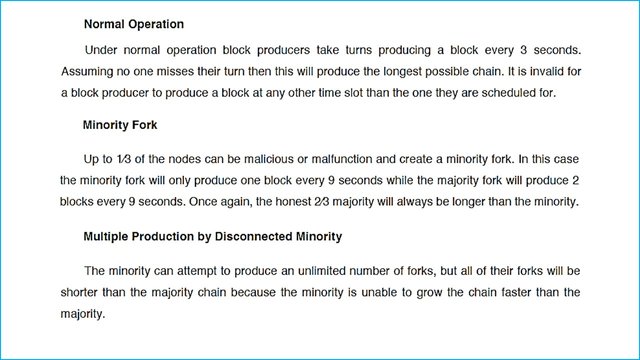
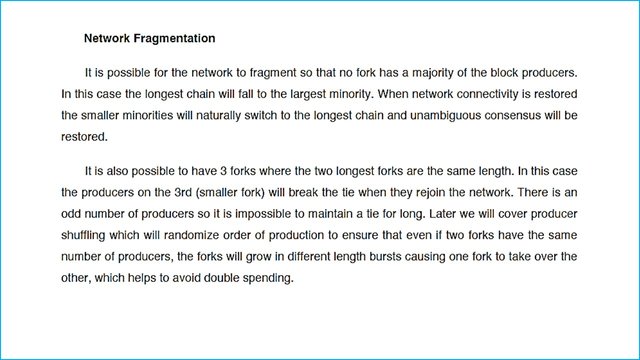
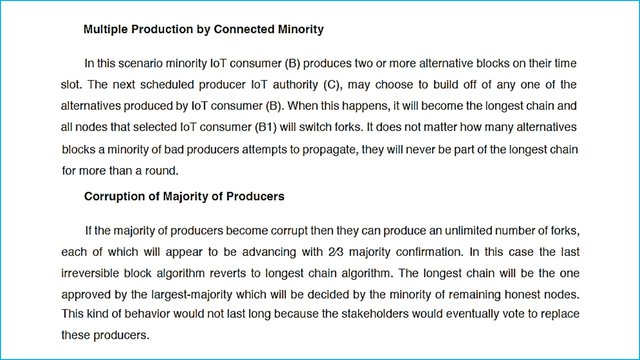
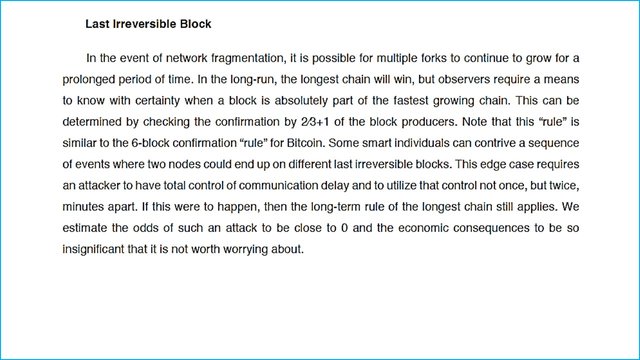
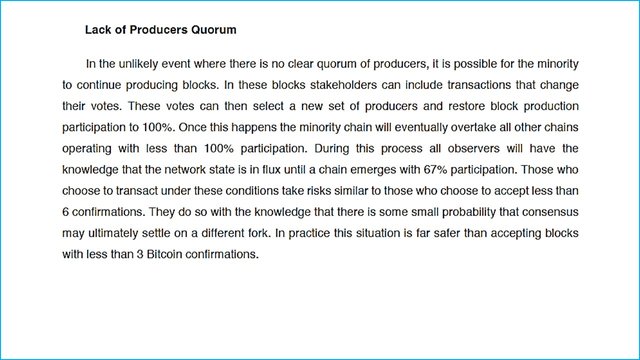
From the examples it is obvious that the IPOS algorithm is indeed robust and secure enough to handle not only nefarious minority attacks but natural network disruptions. The best part is that IPOS can continue to function even when a majority of producers fail; this puts it in a different league compared to other blockchains which would most likely fail. IPOS is designed to optimize performance ensuring 100% honest nodes participation with robust network conditions. At this point there is simply no competing algorithm as robust as IPOS to operate effectively under such varied failure conditions!
6. Data Storage Layer
IONChain provides two ways to store data on the blockchain which are based on IPFS and BigChainDB. The two applications of storage depend on enterprises using them or small users. The IPFS storage is an emerging standard to locate a file depending on the content rather than the location. The name of the file, therefore, will correlate with the content of the file and it will be same in all the systems. So, a computer (or user) can easily verify if their file is right and matches the other file names and their contents.
Future applications of IONChain may require it to store business data and hence IONChain introduces BigChainDB as business storage engine to meet data research requirement. BigChainDB has some advantages of blockchain like decentralization, immutability and asset registration and transfer.
This is what makes the IONChain architecture robust and future ready to deal with progress and improvement in the IoT space; not to mention IONChain itself would be great disruption in the IoT space.

How will having a true IoT economy allow it to grow and hasten the process of mass adoption?
The IoT space so far has been fragmented and chances are it would remain so if progress or interest in the space does not follow. All the progress in this space has more or less been driven by private parties like Amazon, Google and others interested in furthering their solutions. No doubt, even this progress is welcome but it ensures that the siloed nature of IoT progress remains and does not incentivize any player to put their effort into collaboration and standardization.
With IONChain the equation changes a bit. IONChain effectively has a well-thought through solution which combines Blockchain solution with Edge Computing in speeding up IoT response and then uses an innovative IPOS algorithm to run the blockchain effectively while brings in an innovative storage architecture complementing the needs of the IoT industry. In doing so, IONChain has broken the known barriers in the IoT space and has effectively made it easy to incentivize everyone including the device manufacturer, the device user, third parties studying a specific area basis the data from the devices and many more. Effectively, IoT participation improves and there is more reason to join the network. Once beyond a threshold, every other device manufacturer will see the benefit of being in this network to witness what is happening as much as what more can happen. This will then lead to an exponential rise in adoption as users and device manufacturers alike see that the solution benefits them as much as their businesses.

Just imagine an IONChain ecosystem of the future where both Amazon and Google are participants of the network. An Amazon drone out to dispatch a consignment encounters a flock of birds in its flight path. So to avoid a collision the drone has to change altitude with a minor risk of flying into other drones on those flight paths. So, the drone computes the distance to collision with the birds with the help of the Edge Computing technology and uses the time to query Google Maps on spatial information. Google Server provides feedback to gain altitude and remain at that altitude for some time, avoid the flock of birds, and come back to the original altitude. How cool is that?
Two business giants come together to make use of IONChain ecosystem. If not for IONChain there were no converging interests of the two companies to work together.

Why is it important to have a global standard where dAPPs can be developed once to work with all IONChain implemented devices?
Of the many challenges we saw so far in our discussion about the IoT industry, standardization is one of the biggest challenges. While all the efforts of IONChain are true and will indeed bring about changes in the solution and industry, lack of standardization will only delay the progress.
If standardization is brought in at the DApps level or Application layer level then we are looking at standardization of user interface and thereby, easy to bring together different IoT devices under the chain quite easily. Devoid of this, users will be scrambling across applications to use devices and will lead to siloed operations. This is exactly what global standard for DApps will help counter.

Use Cases
Case 1: Amazon Delivery Being Stolen
Mark is an avid buyer from Amazon and is quite a happy customer. However, lately, all his orders are being stolen. This is the case with other neighbors too. Since Mark and his wife both are working, neither are there at home to collect the consignment. This leads to the Amazon delivery man leaving the parcel at their doorstep which eventually gets stolen. He had installed a video camera and had seen the stealing LIVE. But he is fed up getting his consignment stolen and then reporting to the cops.
Mark hears about IONChain and the instant realization of how it could help. He has already installed cameras at his place. At the time of delivery, he gets a call from the delivery man. He switches on his LIVE camera and talks to the delivery man. Using the IONChain DApps, he opens the front door so that the delivery man can push the consignment inside. Once done, he locks the door again and thanks the delivery man. The camera and the door lock are on the IONChain network and help Mark gets his consignment without hassles. This impresses him so much that he tells his neighbors to use the solution to counter the robbery that is happening in their backyard.
Truly, IONChain to the rescue!
-----------------------------------------------******--------------------------------------------------
Case 2: Garment Order Management
Terry manufactures the base garment which a popular design brand buys from him to sell all over America. There are multiple outlets through which they sell and based on consumption, they order garments from Terry. The problem is that the order quantity is quite erratic and being a design house there is no set pattern of buying. Terry has no clue how to manage his inventory. If he produces basis the last month or even last six months consumption, it is either too low (in which case he enters distress production) or too high (in which case he holds high inventory). Both cases lead to loss of money.
Terry comes to know about IONChain and is excited about the possibilities. He convinces the big brand to install the IONChain solution in their Point of Sale (POS) system. Every time, the barcode reader reads the price label for billing, it would help him get real-time information of sales across the hundred and twenty-five outlets. This would then help him plan the production day-wise based on consumption. In fact, the production schedule can also be fed to the system through the IONChain system making the entire chain automated.
Now Terry is a happy man as he is producing to requirement and actually following Just In Time (JIT) production principle. The story of his JIT success reaches others and everyone is excited to try out this new age JIT powered by IONChain.

A look at IONChain Tokenomics
IONC is the official token of the IONChain ecosystem. It will have a total supply of 800 million tokens which will be released over 20 years. At the end of 20 years, the administrative committee can decide whether to re-issue IONC tokens based on the business and blockchain realities of that time.
The current tokenomics is shown in the figure below:
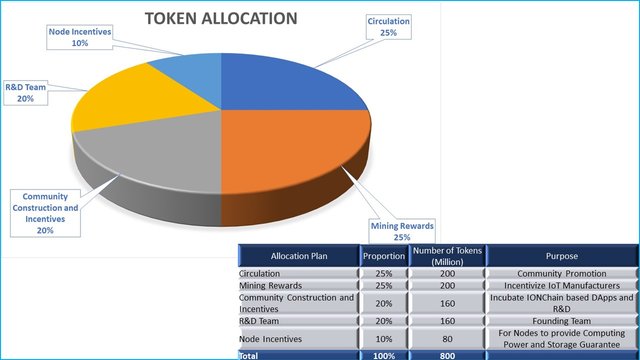

IONChain Roadmap
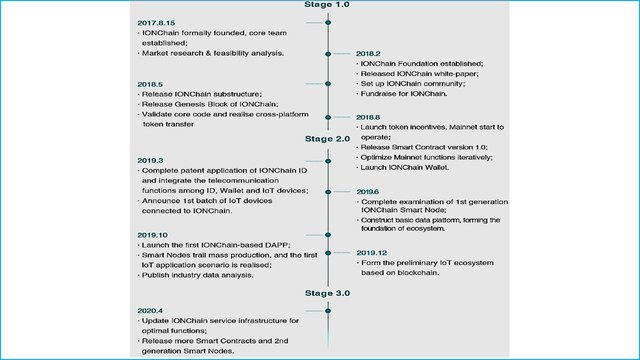

Now, the team behind IONChain
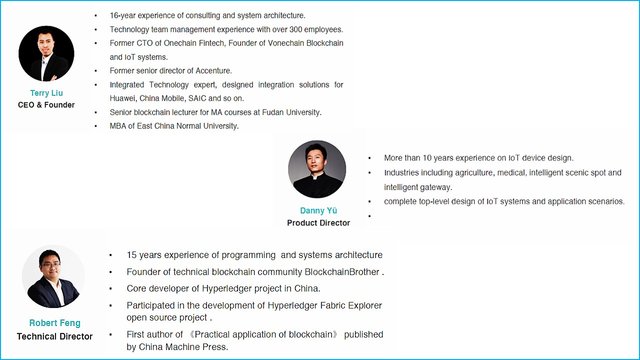
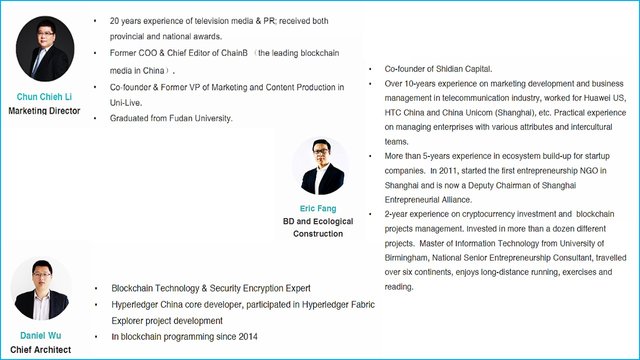

And IONChain Consultants


Summary
At a time when the IoT industry needs an influx of idea or solution to take it to the next level, IONChain comes as not only the idea and solution but also inspiration for the IoT space. The innovative thought process, the well thought-through technologies and the easy to deploy solution ticks all the right boxes.
IONChain is not only here to take IoT space to the next level but also to transform the industry and make it accessible for more players!
-----------------------------------------------******--------------------------------------------------
Here’s my Twitter Link:
https://twitter.com/DawsonSavio/status/1060250109718421504
-----------------------------------------------******--------------------------------------------------
It is also recommended that readers understand more about IONChain through any of the following informative resources.
- IONChain Website
- IONChain Bitcointalk Explanation
- IONChain WhitePaper
- IONChain YouTube
- IONChain Twitter
- IONChain Medium
- IONChain LinkedIn
- IONChain GitHub
- IONChain Steemit
- IONChain Telegram
-----------------------------------------------******--------------------------------------------------
This article is written in response to originalworks’ call on authors’ thoughts on IONChain. It can be read here.
Image Courtesy:Pixabay and IONChain.org Resources
ionchaintwitter
ionchain2018
This post has been submitted for the @OriginalWorks Sponsored Writing Contest!
You can also follow @contestbot to be notified of future contests!
Downvoting a post can decrease pending rewards and make it less visible. Common reasons:
Submit
Congratulations! Your post has been selected as a daily Steemit truffle! It is listed on rank 25 of all contributions awarded today. You can find the TOP DAILY TRUFFLE PICKS HERE.
I upvoted your contribution because to my mind your post is at least 5 SBD worth and should receive 246 votes. It's now up to the lovely Steemit community to make this come true.
I am
TrufflePig, an Artificial Intelligence Bot that helps minnows and content curators using Machine Learning. If you are curious how I select content, you can find an explanation here!Have a nice day and sincerely yours,

TrufflePigDownvoting a post can decrease pending rewards and make it less visible. Common reasons:
Submit